
The Polyporales are an order of about 1800 species of fungi in the division Basidiomycota. The order includes some polypores as well as many corticioid fungi and a few agarics. Many species within the order are saprotrophic, most of them wood-rotters. Some genera, such as Ganoderma and Fomes, contain species that attack living tissues and then continue to degrade the wood of their dead hosts. Those of economic importance include several important pathogens of trees and a few species that cause damage by rotting structural timber. Some of the Polyporales are commercially cultivated and marketed for use as food items or in traditional Chinese medicine.

Polypores are a group of fungi that form large fruiting bodies with pores or tubes on the underside. They are a morphological group of basidiomycetes-like gilled mushrooms and hydnoid fungi, and not all polypores are closely related to each other. Polypores are also called bracket fungi or shelf fungi, and they characteristically produce woody, shelf- or bracket-shaped or occasionally circular fruiting bodies that are called conks.

Lingzhi, Ganoderma sichuanense, also known as reishi or Ganoderma lingzhi is a polypore fungus native to East Asia belonging to the genus Ganoderma.

Laetiporus sulphureus is a species of bracket fungus found in Europe and North America. Its common names are crab-of-the-woods, sulphur polypore, sulphur shelf, and chicken-of-the-woods. Its fruit bodies grow as striking golden-yellow shelf-like structures on tree trunks and branches. Old fruitbodies fade to pale beige or pale grey. The undersurface of the fruit body is made up of tubelike pores rather than gills.

The Polyporaceae are a family of poroid fungi belonging to the Basidiomycota. The flesh of their fruit bodies varies from soft to very tough. Most members of this family have their hymenium in vertical pores on the underside of the caps, but some of them have gills or gill-like structures. Many species are brackets, but others have a definite stipe – for example, Polyporus badius.
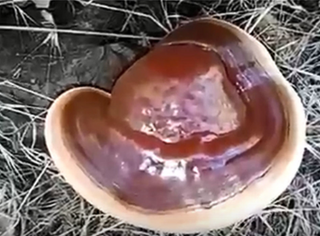
Ganoderma lucidum, commonly known as the reishi, varnished conk, or ling chih, is a red-colored species of Ganoderma with a limited distribution in Europe and parts of China, where it grows on decaying hardwood trees. Wild populations have been found in the United States in California and Utah but were likely introduced anthropogenically and naturalized.

Ganoderma is a genus of polypore fungi in the family Ganodermataceae that includes about 80 species, many from tropical regions. They have a high genetic diversity and are used in traditional Asian medicines. Ganoderma can be differentiated from other polypores because they have a double-walled basidiospore. They may be called shelf mushrooms or bracket fungi.

Ganoderma brownii is a species of polypore fungus in the Ganodermataceae family. It is a plant pathogen and occasional saprotroph similar in appearance to Ganoderma applanatum. This species is restricted geographically to the Pacific Northwest, primarily observed in California. In the San Francisco Bay Area, it is very common on Umbellularia californica.

Cerrena unicolor, commonly known as the mossy maze polypore, is a species of poroid fungus in the genus Cerrena. This saprobic fungus causes white rot.

Daedaleopsis confragosa, commonly known as the thin walled maze polypore or the blushing bracket, is a species of polypore fungus in the family Polyporaceae. A plant pathogen, it causes a white rot of injured hardwoods, especially willows. The fruit bodies are semicircular and tough, have a concentrically zoned brownish upper surface, and measure up to 20 cm (8 in) in diameter. The whitish underside turns gray-brown as the fruit body ages, but bruises pink or red. It is found all year and is common in northern temperate woodlands of eastern North America, Europe, and Asia. The species was first described from Europe in 1791 as a form of Boletus, and has undergone several changes of genus in its taxonomic history. It acquired its current name when Joseph Schröter transferred it to Daedaleopsis in 1888.

Ganoderma tsugae, also known as hemlock varnish shelf, is a flat polypore mushroom of the genus Ganoderma.
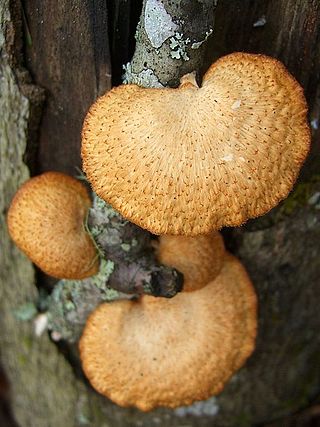
Neofavolus alveolaris, commonly known as the hexagonal-pored polypore, is a species of fungus in the family Polyporaceae. It causes a white rot of dead hardwoods. Found on sticks and decaying logs, its distinguishing features are its yellowish to orange scaly cap, and the hexagonal or diamond-shaped pores. It is widely distributed in North America, and also found in Asia, Australia, and Europe.

Exsudoporus frostii, commonly known as Frost's bolete or the apple bolete, is a bolete fungus first described scientifically in 1874. A member of the family Boletaceae, the mushrooms produced by the fungus have tubes and pores instead of gills on the underside of their caps. Exsudoporus frostii is distributed in the eastern United States from Maine to Georgia, and in the southwest from Arizona extending south to Mexico and Costa Rica. A mycorrhizal species, its fruit bodies are typically found growing near hardwood trees, especially oak.

Globifomes is a fungal genus in the family Polyporaceae. It is a monotypic genus, containing the single North American species Globifomes graveolens, commonly known as sweet knot. This fungus is found fruiting singly or in groups on trunks or logs of hardwood trees, primarily oaks. The fruit body consists of a mass of small overlapping hoof-shaped caps arising from a common core. It is initially dull yellow-brown with tan petal-shaped margins, aging to dark brown.

Ganoderma multipileum, commonly known as lingzhi or chizhi, is a species of polypore mushroom.

Boletus curtisii is a species of fungus in the family Boletaceae. It produces small- to medium-sized fruit bodies (mushrooms) with a convex cap up to 9.5 cm (3.7 in) wide atop a slender stem that can reach a length of 12 cm (4.7 in). In young specimens, the cap and stem are bright golden yellow, although the color dulls to brownish when old. Both the stem and cap are slimy or sticky when young. On the underside of the cap are small circular to angular pores. The mushroom is edible, but not appealing. It is found in eastern and southern North America, where it grows in a mycorrhizal association with hardwood and conifer trees. Once classified as a species of Pulveroboletus, the yellow color of B. curtisii is a result of pigments chemically distinct from those responsible for the yellow coloring of Pulveroboletus.
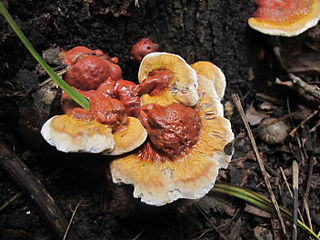
Ganoderma sessile is a species of polypore fungus in the Ganodermataceae family. There is taxonomic uncertainty with this fungus since its circumscription in 1902.

Nigroporus vinosus is a species of poroid fungus in the family Steccherinaceae, and the type species of the genus Nigroporus. Its fruit bodies have brownish caps with tinges of purple or red. The cap underside has a pore surface the same colour as the cap, and minute pores. Nigroporus vinosus has a pantropical distribution. It has been recorded from Africa, North America, Central America, South America, Asia, and Oceania. It is a wood-decay fungus that causes a white rot.
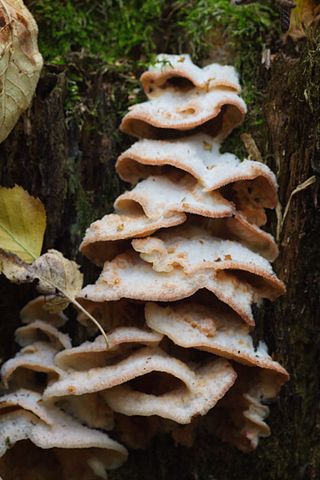
Phlebia tremellosa, commonly known as trembling Merulius or jelly rot, is a species of fungus in the family Meruliaceae. It is a common and widely distributed wood-decay fungus that grows on the rotting wood of both hardwood and conifer plants.
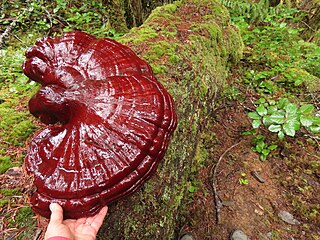
Ganoderma oregonense is a species of bracket fungus that causes root and butt white rot in conifers in northwestern coastal North America, including California, Oregon, Washington, British Columbia, Yukon, and Alaska. G. oregonense is very similar to Ganoderma tsugae, but G. tsugae is associated with east coast Tsuga (hemlock) rather than west coast conifer. Its been speculated that G. oregonense and G. tsugae might actually be one species, but mycologists just don't know for sure yet.




















